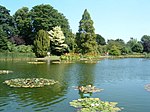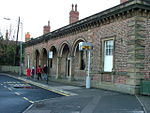Kilnwick Percy

Kilnwick Percy is a village and former civil parish, now in the parish of Nunburnholme, in the East Riding of Yorkshire, England. It is situated approximately 1.5 miles (2.4 km) north-east of Pocklington town centre, and to the north of the B1246 road. In 1931 the parish had a population of 69. On 1 April 1935 the parish was abolished and merged with Nunburnholme.Kilnwick Percy Hall is a Grade II* listed country house built around 1845. It is now a Buddhist meditation and retreat centre. The grounds of the hall include a lake and a small church in the Norman style dedicated to Saint Helen. The church is designated a Grade II listed building and is now recorded in the National Heritage List for England, maintained by Historic England.In 1823 Kilnwick Percy was a civil parish in the Wapentake and Liberty of Holderness. The ecclesiastical parish was under the patronage of the Dean of York. Population at the time was 43.
Excerpt from the Wikipedia article Kilnwick Percy (License: CC BY-SA 3.0, Authors, Images).Kilnwick Percy
Kilnwick Road,
Geographical coordinates (GPS) Address Nearby Places Show on map
Geographical coordinates (GPS)
| Latitude | Longitude |
|---|---|
| N 53.939986 ° | E -0.743492 ° |
Address
Madhyamaka Buddhist Centre
Kilnwick Road
YO42 1UF , Nunburnholme
England, United Kingdom
Open on Google Maps







